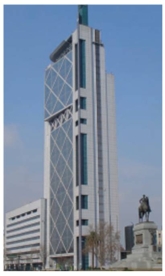B) False
Correct Answer

verified
Correct Answer
verified
Multiple Choice
 -The building above (Figure 3.36 in textbook) has been strengthened by
-The building above (Figure 3.36 in textbook) has been strengthened by
A) adding infill walls.
B) adding frames to the exterior.
C) adding a buttress.
D) isolating the building from the ground.
E) adding braces.
G) B) and C)
Correct Answer

verified
Correct Answer
verified
True/False
When you compare L,S,and P waves on the graph arrival time (Y axes)versus epicentral distance (X axes),the position of L waves will be below P waves.
B) False
Correct Answer

verified
Correct Answer
verified
True/False
Aftershocks are smaller than the mainshock in an earthquake sequence.
B) False
Correct Answer

verified
Correct Answer
verified
Multiple Choice
Seismic waves were amplified at four sites with different foundation (soil) materials in Ottawa during the 2005 Charlevoix earthquake.At which site were they preferentially amplified?
A) rock
B) 10m soil
C) 1m soil
D) 50m soil
E) none of these;seismic waves are not affected by the type or thickness of the soil material
G) B) and C)
Correct Answer

verified
Correct Answer
verified
Multiple Choice
Buildings made of wood tend to ________ than a stiffer building of brick or concrete.
A) fail under compression
B) deform elastically
C) suffer brittle failure
D) none of these
F) A) and C)
Correct Answer

verified
Correct Answer
verified
True/False
Typically fewer than 20 major and great earthquakes (magnitudes of 7 and higher)each year account for more than 90 percent of the energy released by earthquakes.
B) False
Correct Answer

verified
Correct Answer
verified
Multiple Choice
In Sichuan Province,China,the 2008 earthquake particularly affected:
A) roads
B) private houses
C) bridges
D) schools
E) none of these choices
G) A) and C)
Correct Answer

verified
Correct Answer
verified
Multiple Choice
The point where a fault first ruptures is called the _____________.
A) epicentre
B) hypocentre
C) foreshock
D) faultcentre
E) seismocentre
G) A) and E)
Correct Answer

verified
Correct Answer
verified
True/False
Earthquake magnitude scales such as the Richter scale assess the effects on people and buildings.
B) False
Correct Answer

verified
Correct Answer
verified
Multiple Choice
The frequency of a wave is ____________________.
A) the amount of displacement of the medium through which the wave is passing
B) the number of full wave cycles passing a given point per unit time
C) the time between successive waves
D) the energy of the wave
F) B) and C)
Correct Answer

verified
Correct Answer
verified
Multiple Choice
The moment of magnitude scale is more accurate for big earthquakes because _______.
A) it includes length of duration of shaking and energy released
B) it includes fault-rupture area and energy released
C) it includes the distance from the epicentre and length of duration of shaking
D) it includes hypocentre depth and energy released
E) it includes fault-rupture area and hypocentre depth
G) B) and C)
Correct Answer

verified
Correct Answer
verified
True/False
Locate the epicentre and estimate the magnitude of an earthquake from seismogram measurements.
B) False
Correct Answer

verified
Correct Answer
verified
Multiple Choice
The epicentres at divergent zones follow the ______________ and appear at _______ depths.
A) stretched lithosphere;long
B) subduction zone;shallow
C) C,triple junction;long
D) thin and stretched lithosphere;shallow
E) trench zone;shallow
G) C) and E)
Correct Answer

verified
Correct Answer
verified
Multiple Choice
"Megathrust earthquakes" which release enormous amounts of energy and cause widespread destruction are generated at ___________.
A) subduction zones
B) continent to continent collisions
C) transform faults
D) hot spots
F) A) and B)
Correct Answer

verified
Correct Answer
verified
True/False
The biggest shaking event is called the mainshock,the smaller ones before it are known as foreshocks,and the smaller ones after it are called aftershocks.
B) False
Correct Answer

verified
Correct Answer
verified
Multiple Choice
Which of the following statements about faults are correct?
A) They are surface features extending no more than 0.5 metres below the surface.
B) A fault rupture is a one-time movement that produces an earthquake.
C) A crack in the Earth across which the two slides move relative to each other.
D) They are the point on the surface directly above the epicentre.
F) A) and D)
Correct Answer

verified
Correct Answer
verified
Multiple Choice
The study of Earthquakes is known as __________.
A) quakology
B) terrology
C) quassology
D) collapsology
E) seismology
G) B) and E)
Correct Answer

verified
Correct Answer
verified
Multiple Choice
Instrumentation used to measure Earth motion are called ________ and these movements are recorded on a ___________________.
A) quakemeters;richtergraph
B) terrameters;terrachart
C) seismometers;seismograph
D) seismomgraphs;seismochart
F) A) and D)
Correct Answer

verified
Correct Answer
verified
True/False
With their up-and-down and side-to-side motions,S-waves shake the ground surface and can do severe damage to buildings.
B) False
Correct Answer

verified
Correct Answer
verified
Showing 21 - 40 of 67
Related Exams